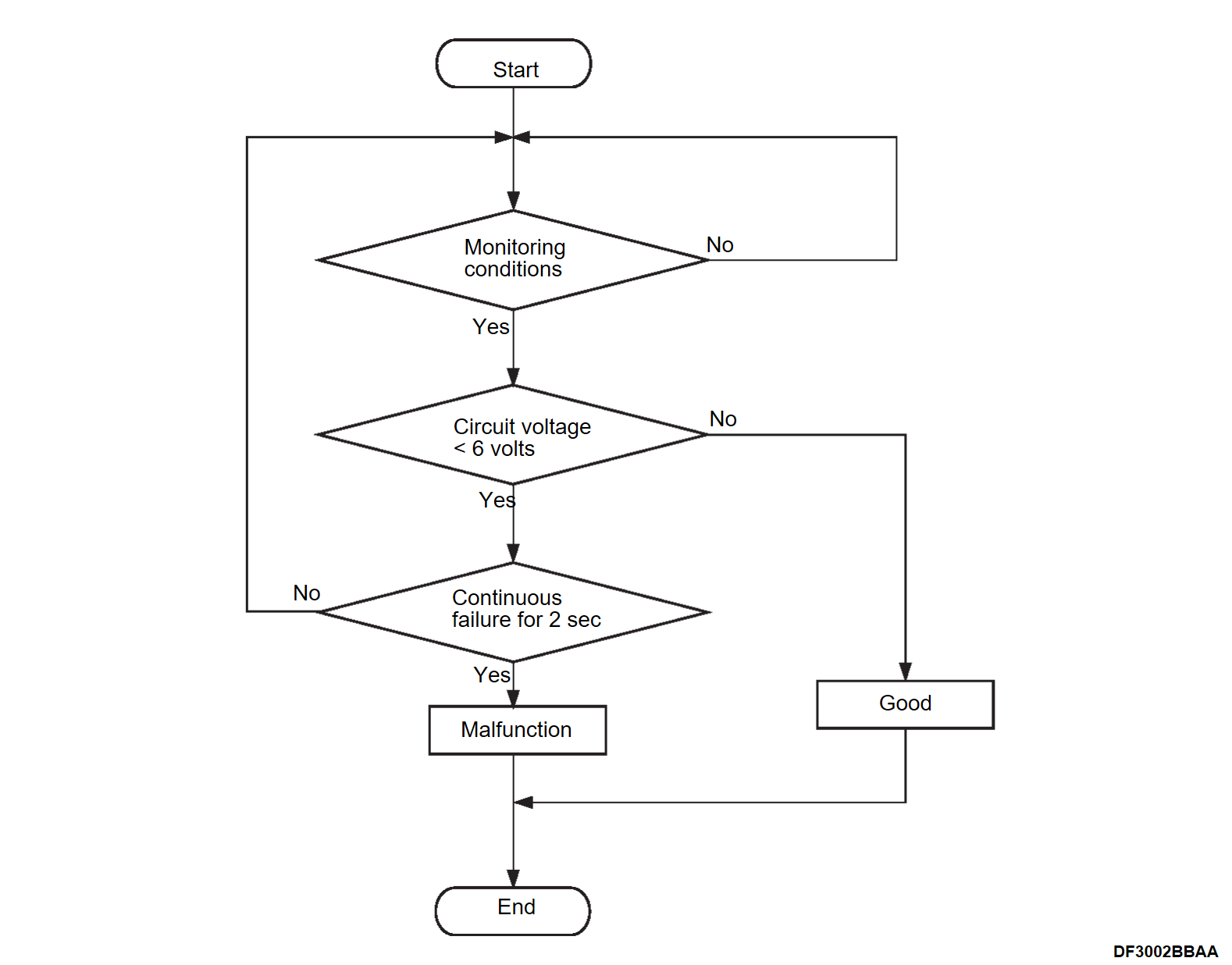DTC P1603-14: Battery backup circuit malfunction
CIRCUIT OPERATION
The 12V battery voltage is applied to the ECM connector terminal number 100 through the IPDM E/R.
TECHNICAL DESCRIPTION
The ECM checks the open circuit of battery backup line.
| note | When the system detects an open circuit in the battery backup line, it makes 1 failure judgment of other diagnostic trouble codes (DTCs). |
DESCRIPTIONS OF MONITOR METHODS
Battery backup line voltage is under specified value.
MONITOR EXECUTION
Continuous.
MONITOR EXECUTION CONDITIONS (Other monitor and Sensor)
Other Monitor (There is no temporary DTC set in memory for the item monitored below)
- Not applicable
Sensor (The sensor below is determined to be normal)
- Not applicable
DTC SET CONDITIONS
Check Conditions
- Power supply mode of electric motor switch is ON.
- 12V battery positive voltage is higher than 10 volts.
Judgment Criterion
- Battery backup line voltage has continued to be lower than 6 volts for 2 seconds.
FAIL-SAFE AND BACKUP FUNCTION
- All DTC are set when the judgment criterion is met once.
- Indicates "REFUELING SYSTEM SERVICE REQUIRED" on the information screen in the multi-information display.
OBD-II DRIVE CYCLE PATTERN
Refer to Diagnostic Function, OBD-II Drive Cycle – Pattern 1 OBD- II DRIVE CYCLE .
.
 .
.TROUBLESHOOTING HINTS (The most likely causes for this code to be set are:)
- IPDM E/R failed.
- Open or shorted battery backup line, harness damage or connector damage.
- ECM failed.
DIAGNOSIS
Required Special Tools:
- MB992744: Vehicle communication interface-Lite (V.C.I.-Lite)
- MB992745: V.C.I.-Lite main harness A
- MB992747: V.C.I.-Lite USB cable short
- MB992748: V.C.I.-Lite USB cable long
1.STEP 1. Using scan tool (M.U.T.-III SE), read the DTC.
(1) Change the power supply mode of the electric motor switch to OFF and wait for 10 seconds or more, then change the power supply mode of the electric motor switch to ON.
(2) Use scan tool (M.U.T.-III SE) to check and see if a DTC P1603-14 is set.
Q: Is DTC P1603-14 set?
 Intermittent malfunction (Refer to GENERAL INFORMATION, General Information – How to Use Troubleshooting/Inspection Service Points – How to Cope with Intermittent Malfunctions HOW TO COPE WITH INTERMITTENT MALFUNCTIONS
Intermittent malfunction (Refer to GENERAL INFORMATION, General Information – How to Use Troubleshooting/Inspection Service Points – How to Cope with Intermittent Malfunctions HOW TO COPE WITH INTERMITTENT MALFUNCTIONS ).
).2.STEP 2. Using scan tool (M.U.T.-III SE), read the other system DTC.
Use scan tool (M.U.T.-III SE) to check and see if a DTC is set in the IPDM E/R [Refer to ELECTRICAL & POWER CONTROL, Power Control System – IPDM E/R – System Description – Diagnosis System (IPDM E/R) M.U.T.-III SE Function (IPDM E/R) ].
]. Perform troubleshooting of IPDM E/R system (Refer to ELECTRICAL & POWER CONTROL, Power Control System – IPDM E/R – System Description – Diagnosis System (IPDM E/R) M.U.T.-III SE Function (IPDM E/R)
Perform troubleshooting of IPDM E/R system (Refer to ELECTRICAL & POWER CONTROL, Power Control System – IPDM E/R – System Description – Diagnosis System (IPDM E/R) M.U.T.-III SE Function (IPDM E/R) ).
).
 ].
].Q: Is any DTC set in the IPDM E/R?
 Perform troubleshooting of IPDM E/R system (Refer to ELECTRICAL & POWER CONTROL, Power Control System – IPDM E/R – System Description – Diagnosis System (IPDM E/R) M.U.T.-III SE Function (IPDM E/R)
Perform troubleshooting of IPDM E/R system (Refer to ELECTRICAL & POWER CONTROL, Power Control System – IPDM E/R – System Description – Diagnosis System (IPDM E/R) M.U.T.-III SE Function (IPDM E/R) ).
).3.STEP 3. Perform voltage measurement at ECM connector terminal number 100
(1) Disconnect connector, and measure at harness side.
(2) Voltage between ECM connector terminal number 100 and ground.
OK: 12V battery positive voltage
Q: Is the check result normal?
 Repair or replace the connector, or check and repair harness between IPDM E/R connector terminal number 44 and ECM connector terminal number 100.
Repair or replace the connector, or check and repair harness between IPDM E/R connector terminal number 44 and ECM connector terminal number 100.4.STEP 4. Check harness between IPDM E/R connector terminal number 44 and ECM connector terminal number 100.
Check power supply line for damage. Repair or replace the connector, or repair the damaged harness wire.
Repair or replace the connector, or repair the damaged harness wire.
Q: Is the check result normal?
 Repair or replace the connector, or repair the damaged harness wire.
Repair or replace the connector, or repair the damaged harness wire.5.STEP 5. Test the OBD-II drive cycle.
After erasing the DTC, carry out test drive with the drive cycle pattern, and recheck the DTC. Replace the ECM (Refer to ENGINE CONTROL MODULE (ECM) REMOVAL AND INSTALLATION
Replace the ECM (Refer to ENGINE CONTROL MODULE (ECM) REMOVAL AND INSTALLATION ).
). Intermittent malfunction (Refer to GENERAL INFORMATION, General Information – How to Use Troubleshooting/Inspection Service Points – How to Cope with Intermittent Malfunctions HOW TO COPE WITH INTERMITTENT MALFUNCTIONS
Intermittent malfunction (Refer to GENERAL INFORMATION, General Information – How to Use Troubleshooting/Inspection Service Points – How to Cope with Intermittent Malfunctions HOW TO COPE WITH INTERMITTENT MALFUNCTIONS ).
).
(1) Use scan tool (M.U.T.-III SE) to erase the DTC.
(2) Carry out test drive with the drive cycle pattern (Refer to Diagnostic Function, OBD-II Drive Cycle – Pattern 1 OBD- II DRIVE CYCLE ).
).
 ).
).(3) Use scan tool (M.U.T.-III SE) to recheck the DTC.
Q: Is DTC P1603-14 set?
 Replace the ECM (Refer to ENGINE CONTROL MODULE (ECM) REMOVAL AND INSTALLATION
Replace the ECM (Refer to ENGINE CONTROL MODULE (ECM) REMOVAL AND INSTALLATION ).
). Intermittent malfunction (Refer to GENERAL INFORMATION, General Information – How to Use Troubleshooting/Inspection Service Points – How to Cope with Intermittent Malfunctions HOW TO COPE WITH INTERMITTENT MALFUNCTIONS
Intermittent malfunction (Refer to GENERAL INFORMATION, General Information – How to Use Troubleshooting/Inspection Service Points – How to Cope with Intermittent Malfunctions HOW TO COPE WITH INTERMITTENT MALFUNCTIONS ).
).![[Previous]](../../../buttons/fprev.png)
![[Next]](../../../buttons/fnext.png)
